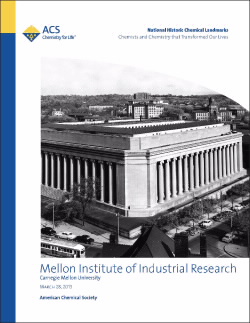Mellon Institute of Industrial Research, Carnegie Mellon University
National Historic Chemical Landmark
Dedicated March 28, 2013, at Carnegie Mellon University in Pittsburgh, Pennsylvania.
Prior to its merger with the Carnegie Institute of Technology in 1967 to form Carnegie Mellon University, the nonprofit Mellon Institute for Industrial Research was a major, independent research corporation dedicated to promoting applied research for industry and educating scientific researchers for the benefit of society as a whole. The Institute educated hundreds of fellows for careers in industrial research and helped to sell the very idea of research to manufacturers. Numerous companies and innovations grew out of research performed at the Institute, including Visking Corp., Plaskon Co., Dow-Corning Corp., the Chemical Division of Union Carbide Corporation, and the first gas mask for use in World War I.
Contents
Duncan’s industrial fellowships
The industrial fellowship concept, the formative idea behind the Mellon Institute, was conceived by Robert Kennedy Duncan (1868–1914). Duncan, a professor of industrial chemistry at the University of Kansas, focused on promoting the application of science—particularly chemistry—by American manufacturers.
Duncan was interested in the state of manufacturing in America, especially in the inefficiency of industrial processes at the turn of the 20th century and the potential for scientific solutions to manufacturing problems. At the time, connections between the scientific research of the university and the applied technology of the factory were largely undeveloped.
Duncan conducted surveys on the working conditions of chemists employed by American manufacturers and studied the application of science by European industries. Recognizing that American business presented “a chaos of confusion and waste” in comparison to its European counterparts, Duncan set about to apply scientific talent to solving manufacturing deficiencies.
In his 1907 book, The Chemistry of Commerce, Duncan proposed a program of industrial fellowships that would employ university researchers in the investigation of manufacturing concerns. In the same year, he oversaw the establishment of the first such fellowship at the University of Kansas to investigate chemical problems in laundering. Duncan quickly became convinced of the merits of the industrial fellowship system and grew the program to eight fellowships by 1909.
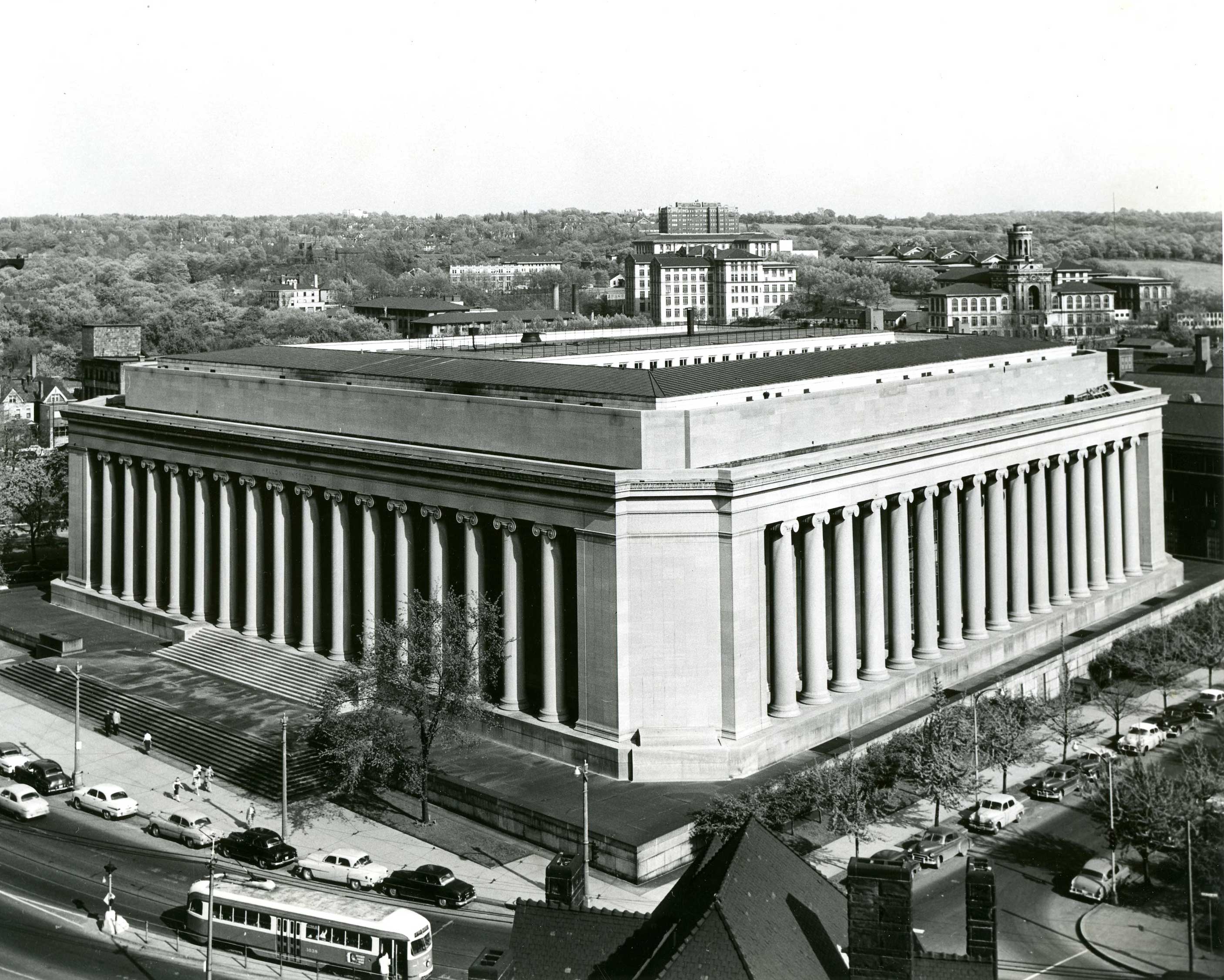
"Everywhere throughout America, wherever there is the smoke of a factory chimney, there are unsolved, exasperating, vitally important manufacturing problems... problems wherever man deals with substance. It seems clear that these problems can best be answered by combining the practical knowledge and the large facilities of the factory with the new and special knowledge of the universities, and by making this combination through young men who will find therein success and opportunity.”
—Robert Kennedy Duncan, The Chemistry of Commerce, 1907
History of the Mellon Institute
The brothers Andrew W. (1855–1937) and Richard B. Mellon (1858–1933), prominent Pittsburgh financiers and philanthropists, were alert to the manufacturing deficiencies Duncan sought to address. Their fortunes having been built largely on the application of new technologies in industry, the brothers understood the promise of science to the progress of industry.
At the brothers’ request, Duncan met with University of Pittsburgh Chancellor Samuel B. McCormick (1858–1928) in 1910 to discuss expanding the fellowship program in Pittsburgh, one of the nation’s leading industrial centers. With the backing of the Mellon brothers, Duncan moved to Pittsburgh to organize and direct the Mellon Institute of Industrial Research and School of Specific Industries, founded in 1913 within the University of Pittsburgh.
The Institute’s mission was to conduct comprehensive scientific investigations that would serve industry and benefit mankind through the development of industry. Fellowships were contracted by industrial sponsors to investigate specific problems. Fellows ranged from young scientists without advanced degrees (which they were encouraged to attain, and many did, through the University of Pittsburgh or in later years through the Carnegie Institute of Technology) to senior fellows who held academic positions at nearby universities. Fellows had access to the Institute’s extensive library, research facilities, and other resources.
No fellowship was accepted for a period of less than one year, and many fellowships spanned terms of 10 years or longer. Any discoveries resulting from Mellon Institute investigations belonged to the sponsoring organization, but the Institute reserved the right to publish the results of its investigations after a period of three years following the conclusion of the fellowship (publishing rights later became more restrictive).
From its inception the Institute emphasized research spanning the fields of chemistry, physics, biology, and engineering. Fellowships in basic research dated from the 1920s and expanded significantly in 1956 with the creation of a program of independent research.
Duncan died in 1914, shortly before the opening of a dedicated building for the Mellon Institute on the University of Pittsburgh campus in 1915 (now Allen Hall). Edward R. Weidlein (1887–1983), formerly Duncan’s assistant, became acting director in 1921 and remained at the head of the Institute until his retirement in 1956. Weidlein, a prominent chemist, served on the nation’s War Production Board during World War II and was awarded the Priestley Medal by the American Chemical Society in 1948.
In 1927 the Institute was incorporated as an independent, nonprofit organization, and its name was changed to the Mellon Institute of Industrial Research (shortened in 1962 to Mellon Institute). Despite its independence, the Institute continued to cooperate with the University of Pittsburgh and the nearby Carnegie Institute of Technology. The Institute operated from the University of Pittsburgh campus until the current Mellon Institute building opened in 1937 at the intersection of Fifth Avenue and Bellefield Avenue. The following two decades saw steady increases in both sponsorships and staff.
The Mellon Institute played an important role in promoting the application of science to industrial concerns for more than 50 years, but by the 1960s the research environment in the United States had changed dramatically. Most major corporations operated research laboratories of their own, partly due to the success of the Mellon Institute at promoting the benefits of such research. A major expansion in federally funded research programs and an increased emphasis on fundamental research efforts precipitated a reevaluation of the Institute’s mission and organization. Having trained over 1,000 scientists through fellowships sponsored by more than 100 companies and ushered in a new era of applied scientific research for the nation, the Mellon Institute merged with the Carnegie Institute of Technology in 1967 to form Carnegie Mellon University.
"The new processes and new powers which science will discover will in the future give man the chance to live and to live more abundantly.”
—Andrew W. Mellon at the 1937 dedication of the Mellon Institute building

Developments from the Mellon Institute
Mellon Institute researchers contributed more than 4,700 papers, 1,600 patents, and various other research products from its inception in 1913 until its merger with the Carnegie Institute of Technology. The first gas mask used during World War I was developed at the Institute, and during World War II the Institute participated in the successful development of synthetic rubber. Other notable developments are described below.
Petrochemical industry and Union Carbide Chemicals
George O. Curme, Jr. (1888–1976), joined the Mellon Institute in 1914 as a fellow sponsored by the Prest-O-Lite Company to study alternative routes for producing acetylene. The following year, Curme discovered a method for producing acetylene from petroleum, a by-product of which was ethylene. Although no commercial uses were known at the time, Curme recognized ethylene’s potential as a starting material for a wealth of organic compounds.
Prest-O-Lite was absorbed by the Union Carbide and Carbon Company in 1917, and the fellowship program continued. In 1920 Curme left the Mellon Institute to lead research into commercial uses for the byproducts of petroleum processing at the newly formed Carbide and Carbon Chemicals Corporation of Union Carbide. The company opened an ethylene glycol antifreeze production facility in 1925, launching an important branch of the petrochemical industry. Since then, ethylene and its related offshoots have become some of the most widely used chemicals in the world.
Air quality studies in Pittsburgh
Pittsburgh’s economic role as a center of industry—particularly coal and steel industries—at the turn of the 20th century came with a significant downside: Rampant air pollution led to the city being described as “the Smoky City.”
The Mellon Institute performed early and influential scientific investigations into air pollution, beginning with the Mellon Institute Smoke Investigation between 1911 and 1914. Subsequent studies on smoke abatement and particulates continued into the 1940s. These studies established connections between air pollution and public health and played an important role in the study and promotion of Pittsburgh-area environmental improvements in the 20th century.
 Organosilicones and Dow Corning Corporation
Organosilicones and Dow Corning Corporation
Under a fellowship sponsored by the Macbeth-Evans Glass Company in the early 1930s, Rob McGregor (1892–1965), John Speier (1918–2003), Earl Warrick (1911–2002), and others investigated the use of silicates as adhesives for glass blocks. The fellowship continued after the company’s purchase by the Corning Glass Works in 1936, and the qualities of materials being produced from silicates were so promising that, in 1943, Corning and The Dow Chemical Company established the Dow Corning Corporation to jointly pursue research in the development and manufacture of organosilicones.
McGregor, Speier, and Warrick left Pittsburgh for Dow Corning’s laboratories in Midland, Michigan, but the company continued to support a team of Mellon fellows investigating potential uses for organosilicones. Their discoveries produced electrical insulating materials used in WWII aircraft and submarines, rubber-like materials from silicone, and various other silicone polymers with assorted uses.
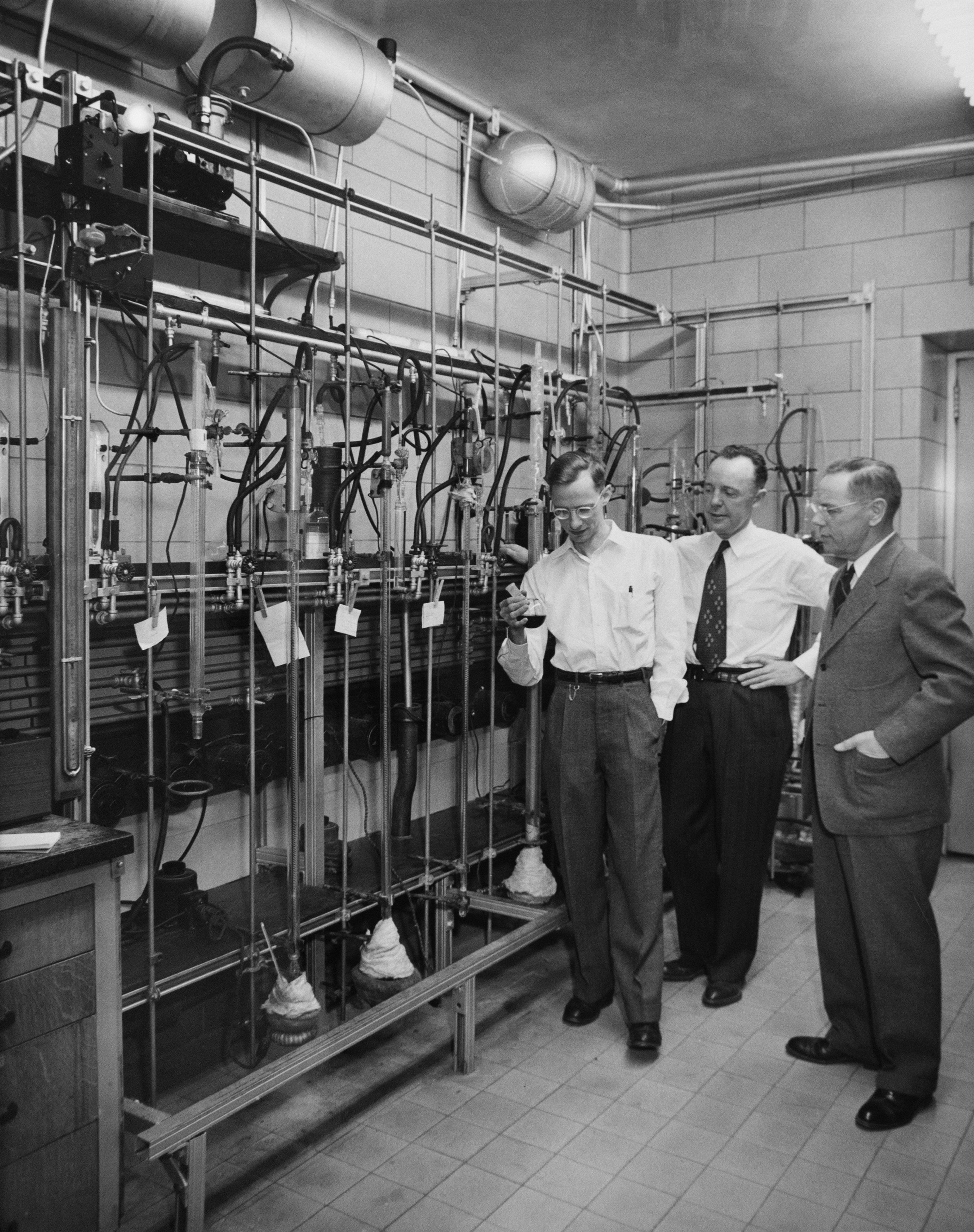
"From the beginning, the objective of the Institute has been for the benefit of humanity, to create new products, to cut costs, to increase employment and to help raise the standard of living. We have established many new industries, thousands of new products, and placed 229 of our people in management positions in industry...”
—Edward R. Weidlein at the 50th anniversary of the Mellon Institute in 1963
Landmark dedication and acknowledgments
Landmark dedication
The American Chemical Society dedicated the Mellon Institute of Industrial Research as a National Historic Chemical Landmark at Carnegie Mellon University in Pittsburgh, Pennsylvania, on March 28, 2013. The text of the plaque commemorating the development reads
The Mellon Institute of Industrial Research was established in 1913 by Andrew W. and Richard B. Mellon to conduct comprehensive scientific investigations that would serve industry and benefit mankind through the development of industry. The Institute provided research services from its inception through World War II, at a time when relatively few manufacturers operated research laboratories of their own. Hundreds of scientists were trained in fundamental and applied research, many of whom went on to careers in industrial research and development, and companies such as Dow Corning Corporation and the chemical division of Union Carbide Corporation were founded on research performed at the Institute. Located in this building since 1937, the Mellon Institute merged with the Carnegie Institute of Technology in 1967 to form Carnegie Mellon University.
Acknowledgments
Adapted for the internet from “Mellon Institute of Industrial Research,” produced by the National Historic Chemical Landmarks program of the American Chemical Society in 2013.
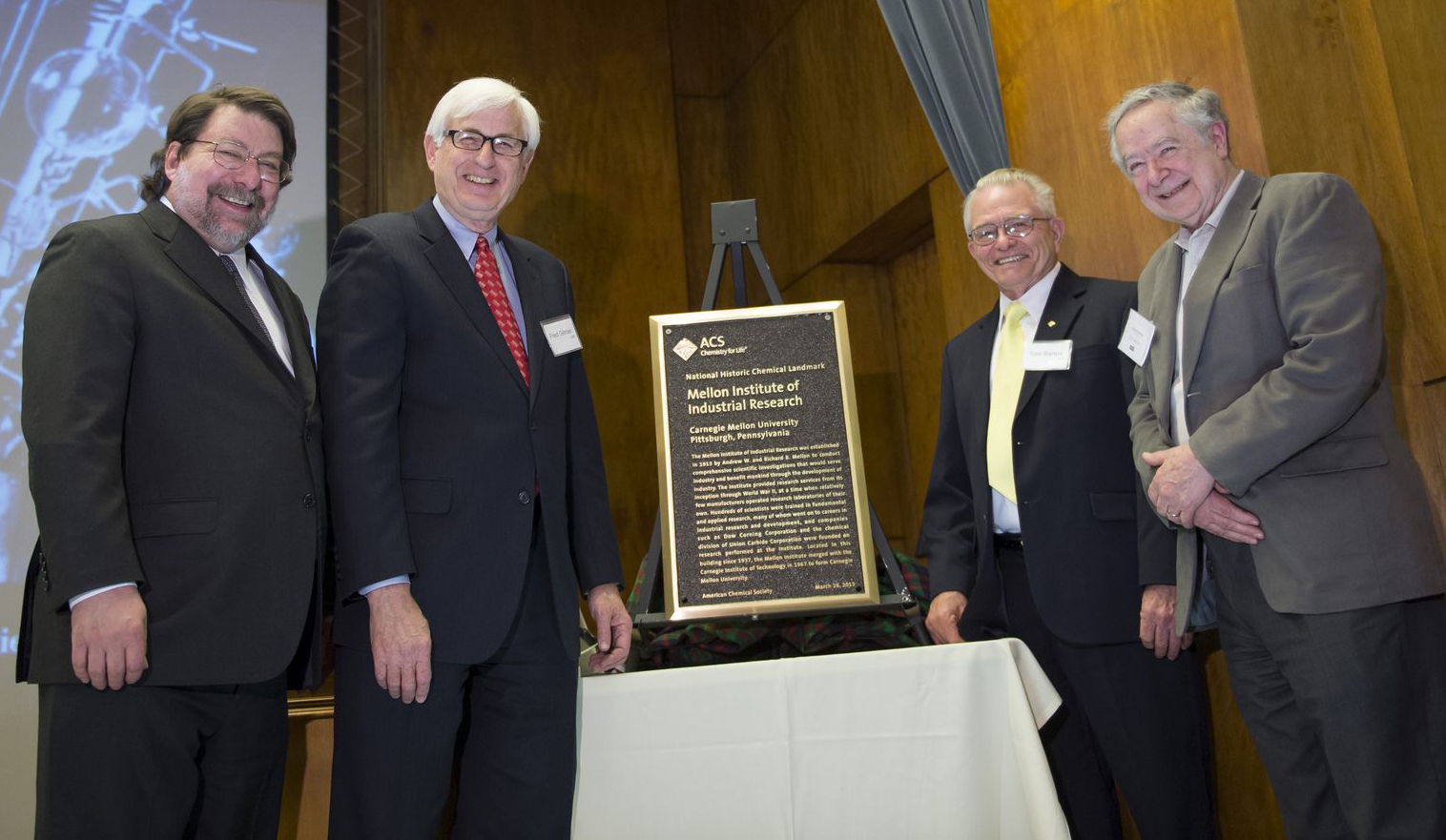
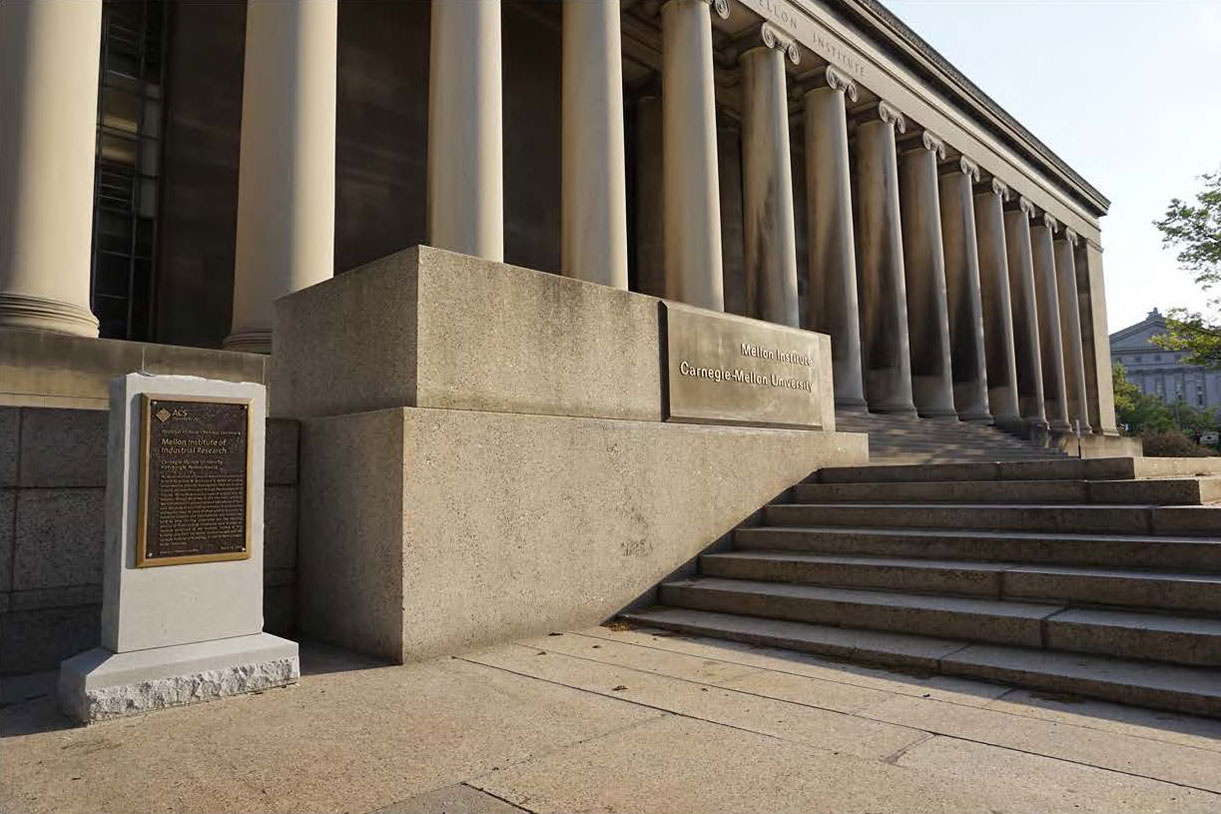
Research resources
Further reading
- Mellon Institute National Historic Chemical Landmark (Carnegie Mellon University)
- George O. Curme (Chemical Heritage Foundation)
- Highlights from the history of Dow Corning Corporation, the silicon pioneer (Dow Corning Corporation)
- Union Carbide Corporation History (Union Carbide Corporation)
Cite this page
American Chemical Society National Historic Chemical Landmarks. Mellon Institute of Industrial Research. http://www.acs.org/content/acs/en/education/whatischemistry/landmarks/mellon-institute.html (accessed Month Day, Year).
Learn more: About the Landmarks Program
Take action: Nominate a Landmark and Contact the NHCL Coordinator

